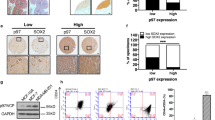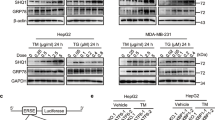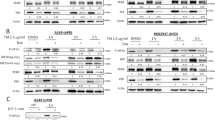Abstract
Secretory clusterin (sCLU) is a stress-induced, pro-survival glycoprotein elevated in early-stage cancers, in particular in APC/Min-defective colon cancers. sCLU is upregulated after exposure to various cytotoxic agents, including ionizing radiation (IR), leading to a survival advantage. We found that stimulation of insulin-like growth factor-1 (IGF-1) and IGF-1R protein kinase signaling was required for sCLU induction after IR exposure. Here, we show that activation of Ataxia telangiectasia-mutated kinase (ATM) by endogenous or exogenous forms of DNA damage was required to relieve basal repression of IGF-1 transcription by the p53/NF-YA complex, leading to sCLU expression. Although p53 levels were stabilized and elevated after DNA damage, dissociation of NF-YA, and thereby p53, from the IGF-1 promoter resulted in IGF-1 induction, indicating that NF-YA was rate limiting. Cells with elevated endogenous DNA damage (deficient in H2AX, MDC1, NBS1, mTR or hMLH1) or cells exposed to DNA-damaging agents had elevated IGF-1 expression, resulting in activation of IGF-1R signaling and sCLU induction. In contrast, ATM-deficient cells were unable to induce sCLU after DNA damage. Our results integrate DNA damage resulting from genetic instability, IR, or chemotherapeutic agents, to ATM activation and abrogation of p53/NF-YA-mediated IGF-1 transcriptional repression, that induces IGF-1–sCLU expression. Elucidation of this pathway should uncover new mechanisms for cancer progression and reveal new targets for drug development to overcome resistance to therapy.
This is a preview of subscription content, access via your institution
Access options
Subscribe to this journal
Receive 50 print issues and online access
$259.00 per year
only $5.18 per issue
Buy this article
- Purchase on Springer Link
- Instant access to full article PDF
Prices may be subject to local taxes which are calculated during checkout






Similar content being viewed by others
References
Andarawewa KL, Erickson AC, Chou WS, Costes SV, Gascard P, Mott JD et al. (2007). Ionizing radiation predisposes nonmalignant human mammary epithelial cells to undergo transforming growth factor beta induced epithelial to mesenchymal transition. Cancer Res 67: 8662–8670.
Bellorini M, Lee DK, Dantonel JC, Zemzoumi K, Roeder RG, Tora L et al. (1997). CCAAT binding NF-Y-TBP interactions: NF-YB and NF-YC require short domains adjacent to their histone fold motifs for association with TBP basic residues. Nucleic Acids Res 25: 2174–2181.
Bentle MS, Reinicke KE, Bey EA, Spitz DR, Boothman DA . (2006). Calcium-dependent modulation of poly(ADP-ribose) polymerase-1 alters cellular metabolism and DNA repair. J Biol Chem 281: 33684–33696.
Bocchetta M, Eliasz S, De Marco MA, Rudzinski J, Zhang L, Carbone M . (2008). The SV40 large T antigen-p53 complexes bind and activate the insulin-like growth factor-I promoter stimulating cell growth. Cancer Res 68: 1022–1029.
Boggs LN, Fuson KS, Baez M, Churgay L, McClure D, Becker G et al. (1996). Clusterin (Apo J) protects against in vitro amyloid-beta (1-40) neurotoxicity. J Neurochem 67: 1324–1327.
Boothman DA, Meyers M, Fukunaga N, Lee SW . (1993). Isolation of x-ray-inducible transcripts from radioresistant human melanoma cells. Proc Natl Acad Sci USA 90: 7200–7204.
Celeste A, Petersen S, Romanienko PJ, Fernandez-Capetillo O, Chen HT, Sedelnikova OA et al. (2002). Genomic instability in mice lacking histone H2AX. Science 296: 922–927.
Chen X, Halberg RB, Ehrhardt WM, Torrealba J, Dove WF . (2003). Clusterin as a biomarker in murine and human intestinal neoplasia. Proc Natl Acad Sci USA 100: 9530–9535.
Chi KN, Hotte SJ, Yu EY, Tu D, Eigl BJ, Tannock I et al. (2010). Randomized phase II study of Docetaxel and Prednisone with or without OGX-011 in patients with metastatic castration-resistant prostate cancer. J Clin Oncol 28: 4247–4254.
Criswell T, Beman M, Araki S, Leskov K, Cataldo E, Mayo LD et al. (2005). Delayed activation of insulin-like growth factor-1 receptor/Src/MAPK/Egr-1 signaling regulates clusterin expression, a pro-survival factor. J Biol Chem 280: 14212–14221.
Criswell T, Klokov D, Beman M, Lavik JP, Boothman DA . (2003). Repression of IR-inducible clusterin expression by the p53 tumor suppressor protein. Cancer Biol Ther 2: 372–380.
D'Arpa P, Beardmore C, Liu LF . (1990). Involvement of nucleic acid synthesis in cell killing mechanisms of topoisomerase poisons. Cancer Res 50: 6919–6924.
de Silva HV, Harmony JA, Stuart WD, Gil CM, Robbins J . (1990). Apolipoprotein J: structure and tissue distribution. Biochemistry 29: 5380–5389.
Dumaz N, Meek DW . (1999). Serine15 phosphorylation stimulates p53 transactivation but does not directly influence interaction with HDM2. EMBO J 18: 7002–7010.
el-Deiry WS, Tokino T, Velculescu VE, Levy DB, Parsons R, Trent JM et al. (1993). WAF1, a potential mediator of p53 tumor suppression. Cell 75: 817–825.
Hao LY, Greider CW . (2004). Genomic instability in both wild-type and telomerase null MEFs. Chromosoma 113: 62–68.
Imbriano C, Gurtner A, Cocchiarella F, Di Agostino S, Basile V, Gostissa M et al. (2005). Direct p53 transcriptional repression: in vivo analysis of CCAAT-containing G2/M promoters. Mol Cell Biol 25: 3737–3751.
Jin G, Howe PH . (1997). Regulation of clusterin gene expression by transforming growth factor beta. J Biol Chem 272: 26620–26626.
Jones SE, Jomary C . (2002). Clusterin. Int J Biochem Cell Biol 34: 427–431.
Klokov D, Criswell T, Leskov KS, Araki S, Mayo L, Boothman DA . (2004). IR-inducible clusterin gene expression: a protein with potential roles in ionizing radiation-induced adaptive responses, genomic instability, and bystander effects. Mutat Res 568: 97–110.
Kojis TL, Gatti RA, Sparkes RS . (1991). The cytogenetics of ataxia telangiectasia. Cancer Genet Cytogenet 56: 143–156.
Leri A, Liu Y, Claudio PP, Kajstura J, Wang X, Wang S et al. (1999). Insulin-like growth factor-1 induces Mdm2 and down-regulates p53, attenuating the myocyte renin-angiotensin system and stretch-mediated apoptosis. Am J Pathol 154: 567–580.
Lou Z, Minter-Dykhouse K, Franco S, Gostissa M, Rivera MA, Celeste A et al. (2006). MDC1 maintains genomic stability by participating in the amplification of ATM-dependent DNA damage signals. Mol Cell 21: 187–200.
Macaulay VM, Salisbury AJ, Bohula EA, Playford MP, Smorodinsky NI, Shiloh Y . (2001). Downregulation of the type 1 insulin-like growth factor receptor in mouse melanoma cells is associated with enhanced radiosensitivity and impaired activation of Atm kinase. Oncogene 20: 4029–4040.
Mantovani R, Li XY, Pessara U, Hooft van Huisjduijnen R, Benoist C, Mathis D . (1994). Dominant negative analogs of NF-YA. J Biol Chem 269: 20340–20346.
Matsui T, Katsuno Y, Inoue T, Fujita F, Joh T, Niida H et al. (2004). Negative regulation of Chk2 expression by p53 is dependent on the CCAAT-binding transcription factor NF-Y. J Biol Chem 279: 25093–25100.
Mayo LD, Donner DB . (2001). A phosphatidylinositol 3-kinase/Akt pathway promotes translocation of Mdm2 from the cytoplasm to the nucleus. Proc Natl Acad Sci USA 98: 11598–11603.
Mittanck DW, Kim SW, Rotwein P . (1997). Essential promoter elements are located within the 5′ untranslated region of human insulin-like growth factor-I exon I. Mol Cell Endocrinol 126: 153–163.
Miyake H, Nelson C, Rennie PS, Gleave ME . (2000). Acquisition of chemoresistant phenotype by overexpression of the antiapoptotic gene testosterone-repressed prostate message-2 in prostate cancer xenograft models. Cancer Res 60: 2547–2554.
Peng Y, Stewart D, Li W, Hawkins M, Kulak S, Ballermann B et al. (2007). Irradiation modulates association of NF-Y with histone-modifying cofactors PCAF and HDAC. Oncogene 26: 7576–7583.
Perry ME, Piette J, Zawadzki JA, Harvey D, Levine AJ . (1993). The mdm-2 gene is induced in response to UV light in a p53-dependent manner. Proc Natl Acad Sci USA 90: 11623–11627.
Ryan PD, Goss PE . (2008). The emerging role of the insulin-like growth factor pathway as a therapeutic target in cancer. Oncologist 13: 16–24.
Shahrabani-Gargir L, Pandita TK, Werner H . (2004). Ataxia-telangiectasia mutated gene controls insulin-like growth factor I receptor gene expression in a deoxyribonucleic acid damage response pathway via mechanisms involving zinc-finger transcription factors Sp1 and WT1. Endocrinology 145: 5679–5687.
So A, Sinnemann S, Huntsman D, Fazli L, Gleave M . (2005). Knockdown of the cytoprotective chaperone, clusterin, chemosensitizes human breast cancer cells both in vitro and in vivo. Mol Cancer Ther 4: 1837–1849.
Stiff T, Walker SA, Cerosaletti K, Goodarzi AA, Petermann E, Concannon P et al. (2006). ATR-dependent phosphorylation and activation of ATM in response to UV treatment or replication fork stalling. EMBO J 25: 5775–5782.
Sulkowski S, Wincewicz A, Zalewski B, Famulski W, Lotowska JM, Koda M et al. (2009). Hypoxia related growth factors and p53 in preoperative sera from patients with colorectal cancer--evaluation of the prognostic significance of these agents. Clin Chem Lab Med 47: 1439–1445.
Wagner MW, Li LS, Morales JC, Galindo CL, Garner HR, Bornmann WG et al. (2008). Role of c-Abl kinase in DNA mismatch repair-dependent G2 cell cycle checkpoint arrest responses. J Biol Chem 283: 21382–21393.
Wang Z, Rose DW, Hermanson O, Liu F, Herman T, Wu W et al. (2000). Regulation of somatic growth by the p160 coactivator p/CIP. Proc Natl Acad Sci USA 97: 13549–13554.
Williams BR, Mirzoeva OK, Morgan WF, Lin J, Dunnick W, Petrini JH . (2002). A murine model of Nijmegen breakage syndrome. Curr Biol 12: 648–653.
Wilson MR, Easterbrook-Smith SB . (2000). Clusterin is a secreted mammalian chaperone. Trends Biochem Sci 25: 95–98.
Yan J, Yu CT, Ozen M, Ittmann M, Tsai SY, Tsai MJ . (2006). Steroid receptor coactivator-3 and activator protein-1 coordinately regulate the transcription of components of the insulin-like growth factor/AKT signaling pathway. Cancer Res 66: 11039–11046.
Yun J, Chae HD, Choy HE, Chung J, Yoo HS, Han MH et al. (1999). p53 negatively regulates cdc2 transcription via the CCAAT-binding NF-Y transcription factor. J Biol Chem 274: 29677–29682.
Yun J, Chae HD, Choi TS, Kim EH, Bang YJ, Chung J et al. (2003). Cdk2-dependent phosphorylation of the NF-Y transcription factor and its involvement in the p53-p21 signaling pathway. J Biol Chem 278: 36966–36972.
Zhang H, Kim JK, Edwards CA, Xu Z, Taichman R, Wang CY . (2005). Clusterin inhibits apoptosis by interacting with activated Bax. Nat Cell Biol 7: 909–915.
Zhao H, Piwnica-Worms H . (2001). ATR-mediated checkpoint pathways regulate phosphorylation and activation of human Chk1. Mol Cell Biol 21: 4129–4139.
Ziv Y, Bar-Shira A, Pecker I, Russell P, Jorgensen TJ, Tsarfati I et al. (1997). Recombinant ATM protein complements the cellular A-T phenotype. Oncogene 15: 159–167.
Acknowledgements
This work was supported by DOE grant (#DE-FG02-06ER64186-17) to DAB, a DOD BCRP pre-doctoral fellowship (W81XWH-06-0748) to EMG and a DOD PCRP post-doctoral fellowship (X8IXWH-09-1-0168) to XL. We are grateful to the Robert B and Virginia Payne Endowment for support of this work. We also thank the support received from the SAIR NIH U24 grant CA126608 and the Imaging Shared Resource of the Simmons Cancer Center. This is CSCN #024 and used the Flow Cytometry and Biostatistics cores of the Simmons Comprehensive Cancer Center.
Author information
Authors and Affiliations
Corresponding author
Ethics declarations
Competing interests
The authors declare no conflict of interest.
Additional information
Supplementary Information accompanies the paper on the Oncogene website
Supplementary information
Rights and permissions
About this article
Cite this article
Goetz, E., Shankar, B., Zou, Y. et al. ATM-dependent IGF-1 induction regulates secretory clusterin expression after DNA damage and in genetic instability. Oncogene 30, 3745–3754 (2011). https://doi.org/10.1038/onc.2011.92
Received:
Revised:
Accepted:
Published:
Issue Date:
DOI: https://doi.org/10.1038/onc.2011.92
Keywords
This article is cited by
-
Clusterin protects against Cr(VI)-induced oxidative stress-associated hepatotoxicity by mediating the Akt-Keap1-Nrf2 signaling pathway
Environmental Science and Pollution Research (2022)
-
HMGB1 induction of clusterin creates a chemoresistant niche in human prostate tumor cells
Scientific Reports (2015)
-
Metabolic reprogramming during TGFβ1-induced epithelial-to-mesenchymal transition
Oncogene (2015)
-
Low dose IR-induced IGF-1-sCLU expression: a p53-repressed expression cascade that interferes with TGFβ1 signaling to confer a pro-survival bystander effect
Oncogene (2013)



